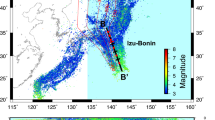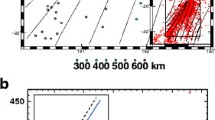Abstract
In this paper we discuss characteristic features of subduction zone seismicity at depths between about 100 km and 700 km, with emphasis on the role of temperature and rheology in controlling the deformation of, and the seismic energy release in downgoing lithosphere. This is done in two steps. After a brief review of earlier developments, we first show that the depth distribution of hypocentres at depths between 100 km and 700 km in subducted lithosphere can be explained by a model in which seismic activity is confined to those parts of the slab which have temperatures below a depth-dependent critical valueT cr.
Second, the variation of seismic energy release (frequency of events, magnitude) with depth is addressed by inferring a rheological evolution from the slab's thermal evolution and by combining this with models for the system of forces acting on the subducting lithosphere. It is found that considerable stress concentration occurs in a reheating slab in the depth range of 400 to 650–700 km: the slab weakens, but the stress level strongly increases. On the basis of this stress concentration a model is formulated for earthquake generation within subducting slabs. The model predicts a maximum depth of seismic activity in the depth range of 635 to 760 km and, for deep earthquake zones, a relative maximum in seismic energy release near the maximum depth of earthquakes. From our modelling it follows that, whereas such a maximum is indeed likely to develop in deep earthquake zones, zones with a maximum depth around 300 km (such as the Aleutians) are expected to exhibit a smooth decay in seismic energy release with depth. This is in excellent agreement with observational data. In conclusion, the incoroporation of both depth-dependent forces and depth-dependent rheology provides new insight into the generation of intermediate and deep earthquakes and into the variation of seismic activity with depth.
Our results imply that no barrier to slab penetration at a depth of 650–700 km is required to explain the maximum depth of seismic activity and the pattern of seismic energy release in deep earthquake zones.
Similar content being viewed by others
References
Aki, K. (1979),Characterization of barriers on an earthquake fault, J. Geophys. Res.84, 6140–6148.
Aki, K. (1984),Asperities, barriers, characteristic earthquakes and strong motions, J. Geophys. Res.89, 5867–5872.
Apperson, K.D. andFrohlich, C. (1987),The relationship between Wadati-Benioff zone geometry and P, T and B axes of intermediate and deep focus earthquakes, J. Geophys. Res.92, 13821–13831.
Bodine, J. H., Steckler, M. S., andWatts, A. B. (1981),Observations of flexure and the rheology of the oceanic lithosphere, J. Geophys. Res.86, 3695–3707.
Byerlee, J. (1978),Friction of rocks, Pure and Appl. Geophys.116, 615–626.
Caldwell, J. G. andTurcotte, D. L. (1979),Dependence of the thickness of the elastic oceanic lithosphere on age, J. Geophys. Res.84, 7472–7576.
Chapple, W. M. andForsyth, D. W. (1979),Earthquakes and bending of plates at trenches, J. Geophys. Res.84, 6729–6749.
Christensen, U. R. andYuen, D. A. (1982),The interaction of a subducting lithospheric slab with a chemical or phase boundary, J. Geophys. Res.89, 4389–4402.
Chung, W.-Y. andKanamori, H. (1980),Variation of seismic source parameters and stress drops within a descending slab and its implications in plate mechanisms, Phys. Earth Planet. Inter.23, 134–159.
Cloetingh, S. andWortel, R. (1986),Stress in the Indo-Australian plate, Tectonophysics132, 49–67.
Creager, K. C. andJordan, T. H. (1984),Slab penetration into the lower mantle, J. Geophys. Res.89, 3031–3049.
Creager, K. C. andJordan, T. H. (1986),Slab penetration into the lower mantle beneath the Mariana and other island arcs of the northwest Pacific, J. Geophys. Res.91, 3573–3590.
Crough, S. T. (1975),Thermal model of oceanic lithosphere, Nature256, 388–390.
Crough, S. T. (1977),Approximate solutions for the formation of the lithosphere, Phys. Earth Planet. Inter.14, 365–377.
Das, S. andAki, K. (1977),Fault planes with barriers: a versatile earthquake model, J. Geophys. Res.82, 5648–5670.
Davies, G. F. (1980),Mechanics of subducted lithosphere, J. Geophys. Res.85, 6304–6318.
Davies, G. F. (1983),Subduction zone stresses: constraints from mechanics and from topographic and geoid anomalies, Tectonophysics99, 85–98.
Deffeyes, K. S. (1972),Plume convection with an upper mantle temperature inversion, Nature240, 539–544.
Elsasser, W. M.,Convection and stress propagation in the upper mantle, InThe Application of Modern Physics to the Earth and Planetary Interiors (S. K. Runcorn, ed.) (Wiley-Interscience, New York 1969), pp. 223–246.
England, P. J. andWortel, R. (1980),Some consequences of the subduction of young slabs, Earth Planet. Sci. Lett.47, 403–415.
Forsyth, D. W. (1975),Fault plane solutions and tectonics of the South Atlantic and Scotia Sea, J. Geophys. Res.80, 1429–1443.
Forsyth, D. W. (1975),Determinations of focal depths of earthquakes associated with the bending of oceanic plates at trenches, Phys. Earth Planet. Inter.28, 141–160.
Fujita, K. andKanamori, H. (1981),Double seismic zones and stresses of intermediate depth earthquakes, Geophys. J. R. Astron. Soc.66, 131–156.
Giardini, D. andWoodhouse, J. H. (1984),Deep seismicity and modes of deformation in Tonga subduction zone, Nature307, 505–509.
Goetze, C. (1978),The mechanisms of creep in olivine, Phil. Trans. R. Soc. London A288, 99–119.
Goetze, C. andEvans, B. (1979),Stress and temperature in the bending lithosphere as constrained by experimental rock mechanics, Geophys. J. R. Astron. Soc.59, 463–478.
Griggs, D. T. (1972).The sinking lithosphere and the focal mechanism of deep earthquakes, InThe Nature of the Solid Earth (E. C. Robertson, J. F. Hays, andL. Knopoff, eds.) (McGraw-Hill Inc., New York, 1972) pp. 361–384.
Griggs, D. T. andBaker, D. W. The origin of deep focus earthquakes, InProperties of Matter Under Unusual Circumstances (H. Mark ans S. Fernback, eds.) (J. Wiley, New York, 1968) pp. 23–42.
Hasebe, K., Fujii, N., andUyeda, S. (1970),Thermal processes under island arcs, Tectonophysics10, 335–355.
House, L. S. andJacob, K. H. (1982),Thermal stresses in subducting lithosphere can explain double seismic zones, Nature295, 587–589.
Isacks, B., Oliver, J., andSykes, L. R. (1968),Seismology and the new global tectonics, J. Geophys. Res.73, 5855–5899.
Isacks, B. andMolnar, P. (1971),Distribution of stresses in the descending lithosphere from a global survey of focal mechanism solutions of mantle earthquakes, Rev. Geophys. Space Phys.9, 103–174.
Jarrard, R. D. (1986),Relations among subduction parameters, Rev. Geophys.24, 217–284.
Kanamori, H.,The nature of seismicity patterns before large earthquakes, InEarthquake Prediction: An International Review (D. W. Simpson and P. G. Richards, eds.) (Maurice Ewing Series 4, AGU, Washington, D.C. 1981) pp. 1–19.
Kawakatsu, H. (1986),Double seismic zones: kinematics, J. Geophys. Res.91, 4811–4825.
Lay, Th. andKanamori, H.,An asperity model of large earthquake sequences, InEarthquake Prediction: An International Review (D. W. Simpson and P. G. Richards, eds.) (Maurice Ewing Series 4, AGU, Washington, D. C. 1981) pp. 579–592.
Le Pichon, X., Francheteau, J., andBonnin, J.,Plate Tectonics (Elsevier, Amsterdam, 1973) 311 pp.
McKenzie, D. P. (1967),Some remarks on heat flow and gravity anomalies, J. Geophys. Res.72, 6261–6273.
McKenzie, D. P. (1969),Speculations on the consequences and causes of plate motions, Geophys. J. R. Astron. Soc.18, 1–32.
McKenzie, D. P. (1970),Temperature and potential temperature beneath island arcs, Tectonophysics10, 357–366.
Minear, J. W. andToksöz, M. N. (1970),Thermal regime of a downgoing slab and new global tectonics, J. Geophys. Res.75, 1397–1419.
Molnar, P., Freedman, D., andShih, J. S. F. (1979),Lengths of intermediate and deep seismic zones and temperatures in downgoing slabs of lithosphere, Geophys. J. R. Astron. Soc.56, 41–54.
O'Connell, R. J. (1977),On the scale of mantle convection, Tectonophysics38, 119–136.
Ogawa, M. (1987),Shear instability in a viscoelastic material as cause of deep-focus earthquakes, J. Geophys. Res.92, 13801–13810.
Ohtani, E. andKumazawa, M. (1981),Melting of forsterite Mg 2SiO4 up to 15 GPa, Phys. Earth Planet. Int.27, 32–38.
Oxburgh, E. R. andTurcotte, D. L. (1970),Thermal structure of island arcs, Geol. Soc. Amer. Bull.81, 1665–1688.
Parsons, B. andSclater, J. G. (1977),An analysis of the variation of ocean floor bathymetry and heat flow with age, J. Geophys. Res.82, 803–827.
Peltier, W. R. andJarvis, G. T. (1982),Whole mantle convection and the thermal evolution of the earth, Phys. Earth Planet. Int.29, 281–304.
Ranalli, G.,Rheology of the Earth: Deformation and Flow Processes in Geophysics and Geodynamics (Allen and Unwin, London, 1987) 366 pp.
Richter, F. M. (1979),Focal mechanisms and seismic energy release of deep and intermediate earthquakes in the Tonga-Kermadec region and their bearing on the depth extent of mantle flow, J. Geophys. Res.84, 6783–6795.
Ruff, L. andKanamori, H. (1980),Seismicity and the subduction process, Phys. Earth Planet. Inter.23, 240–252.
Ruff, L. andKanamori, H. (1983),The rupture process and asperity distribution of three great earthquakes from long-period diffracted P-waves, Phys. Earth Planet. Inter.31, 202–230.
Schatz, J. F. andSimmons, G. (1972),Thermal conductivity of earth materials at high temperatures, J. Geophys. Res.77, 6966–6983.
Shiono, K. andSugi, N. (1985),Life of an oceanic plate: cooling time and assimilation time, Tectonophysics112, 35–50.
Spence, W. (1987),Slab pull and the seismotectonics of subducting lithosphere, Rev. Geophys.25, 55–69.
Stacey, F. D. (1977),A thermal model of the earth, Phys. Earth Planet. Int.15, 341–348.
Stark, P. B. andFrohlich, C. (1985),The depth of the deepest deep earthquakes, J. Geophys. Res.90, 1859–1869.
Toksöz, M. N., Minear, J. W., andJulian, B. R. (1971),Temperature field and geophysical effects of a downgoing slab, J. Geophys. Res.76, 1113–1138.
Truchan, M. andLarson, R. L. (1973),Tectonic lineaments on the Cocos plate, Earth Planet. Sci. Lett.17, 426–432.
Turcotte, D. L. andOxburgh, E. R. (1967),Finite amplitude convection cells and continental drift, J. Fluid Mech.28, 29–42.
Turcotte, D. L. andSchubert, G. (1971),Structure of the olivine-spinel phase boundary in the descending lithosphere, J. Geophys. Res.76, 7980–7987.
Turcotte, D. L. andSchubert, G. (1973),Frictional heating of the descending lithosphere, J. Geophys. Res.78, 5876–5886.
Uyeda, S. andMiyashiro, A. (1974),Plate tectonics and the Japanese islands: A synthesis. Geol. Soc. Am. Bull.85, 1159–1170.
VandenBeukel J. andWortel, R. (1987),Temperatures and shear stresses in the upper part of a subduction zone, Geophys. Res. Lett.14, 1057–1060.
Vassiliou, M. S., Hager, B. H., andRaefsky, A. (1984),The distribution of earthquakes with depth and stress in subducting slabs, J. Geodynamics1, 11–28.
Vlaar, N. J.,The driving mechanism of plate tectonics: a qualitative approach, InProgress in Geodynamics (G. J. Borradaile, A. R. Ritsema, H. E. Rondeel and O. J. Simon, eds.) (North Holland, Amsterdam, 1975) pp. 234–245.
Vlaar, N. J. andWortel, M. J. R. (1976),Lithospheric aging, instability and subduction, Tectonophysics32, 331–351.
Watts, A. B., Bodine, J. H., andSteckler, M. S. (1980),Observations of flexure and the state of stress in the oceanic lithosphere, J. Geophys. Res.85, 6369–6376.
Weertman, J. (1970),The creep strength of the earth's mantle, Rev. Geophys. Space Phys.8, 145–168.
Wiens, D. A. andStein, S. (1983),Age dependence of oceanic intraplate seismicity and implications for lithospheric evolution, J. Geophys. Res.88, 6455–6468.
Wiens, D. A. andStein, S. (1984),Intraplate seismicity and stresses in young oceanic lithosphere, J. Geophys. Res.89, 11442–11464.
Wortel, R. (1980a),Age-dependent subduction of oceanic lithosphere, Ph.D. Thesis, University of Utrecht, 147 pp.
Wortel, M. J. R. (1980b),Comments on “Lengths of intermediate and deep seismic zones and temperatures in downgoing slabs of lithosphere” by Peter Molnar, David Freedman and John S. F. Shih, Geophys. J. R. Astron. Soc.60, 307–313.
Wortel, R. (1982),Seismicity and rheology of subducted slabs, Nature296, 553–556.
Wortel, R. (1986),Deep earthquakes and the thermal assimilation of subducting lithosphere, Geophys. Res. Lett.13, 34–37.
Wortel, M. J. R. andVlaar, N. J. (1978),Age-dependent subduction of oceanic lithosphere beneath western South America, Phys. Earth Planet. Int.17, 201–208.
Author information
Authors and Affiliations
Rights and permissions
About this article
Cite this article
Wortel, M.J.R., Vlaar, N.J. Subduction zone seismicity and the thermo-mechanical evolution of downgoing lithosphere. PAGEOPH 128, 625–659 (1988). https://doi.org/10.1007/BF00874551
Received:
Revised:
Accepted:
Issue Date:
DOI: https://doi.org/10.1007/BF00874551




